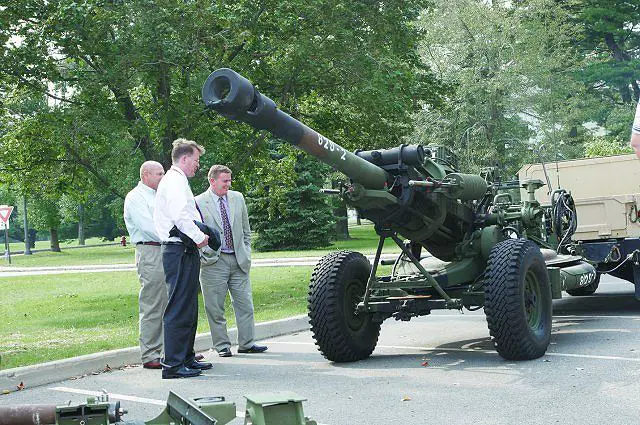Breaking news
United States Army will receive a digitized version of the M119A2 105mm howitzer 0812111.
| a | |||
Defense News - United States |
|||
Thursday, December 8, 2011, 09:19 AM |
|||
| United States Army will receive a digitized version of the M119A2 105mm howitzer. | |||
United States army Soldiers
are one step closer to receiving a digitized M119A2 howitzer that will
make it possible for them to start firing rounds and evade return fire
quicker. The M119A2 is a lightweight 105mm howitzer that provides suppressive
and protective fires for Infantry Brigade Combat Teams. |
|||
 The upgraded M119A2 will be equipped with a digital fire control system that includes an inertial navigation unit, guided-precision system technology and other features that will give the weapon the ability to determine its precise geographical location on its own. (Picture Copyright U.S. Army) |
|||
Program Executive Office, or PEO, Ammunition employees, with help from the Armament Research, Development and Engineering Center, known as ARDEC, recently shipped four M119A2s to various installations for safety testing. The upgraded M119A2
will be equipped with a digital fire control system that includes an
inertial navigation unit, guided-precision system technology and other
features that will give the weapon the ability to determine its precise
geographical location on its own. Using optical sites usually takes troops about 10 minutes to survey and assess their location, aim, and then fire the first round. However, the digitized M119A2 includes a GPS-aided Inertial Navigation Unit, or INU, that knows where the weapon is at all times, so optical sites are not needed to determine location. The INU allows the Soldier to ready the howitzer and fire the first round in two to three minutes. Gooding compared the INU to a GPS navigation unit in a car, only more accurate. "Your Garmin
always knows where you are and where you're going," Gooding explained.
"The INU does the same thing. You drop the howitzer in and it knows
where it is, so you can fire right away." |
|||
 The digitized M119A2 includes a GPS-aided Inertial Navigation Unit that knows where the weapon is at all times, so optical sites are not needed to determine location. The INU allows the Soldier to ready the howitzer and fire the first round in two to three minutes. (Photo credit U.S. Army Erin Usawicz) |
|||
|
SOFTWARE
The software development and integration of the digital fire control system onto the M119A2 was conducted in-house at ARDEC, thus eliminating the need for an outside prime contractor. Ninety percent of the software used on the M119A2 was taken from the M777A2. This provides useful standardization between the Army's three howitzers, the M777A2, the Paladin self-propelled 155mm Howitzer and now the M119A2. "The Paladin software was developed and is now maintained here at Picatinny, the same holds for the M777A2 Howitzer. Now, the software associated with the digitized M119A2 will also claim its roots at Picatinny. The same government lab will have responsibility for the software on all three Army artillery pieces, something that our user, TCM-BCT (TRADOC Capability Manager for Brigade Combat Teams) has been pushing for," Gooding said. Maj.
Jesse Taylor, the user representative for the M119A2 at Fort Sill, has
been working with Picatinny to ensure that the upgrades meet user requirements. Facilities in Building 92 at Picatinny were converted into a maintenance type environment where the howitzers, the digital fire control equipment and the integration documentation were all housed for a three-week period. During this time, the ARDEC engineering community transformed the M119A2 production howitzers into digitized weapons. The detailed, step by step sequence of events required to integrate the digital fire control onto the howitzers were proven out by the team at ARDEC and documented in the MWO. The
end result is howitzers ready for Integration Testing and a validated
MWO which will be used as the baselining document to digitize all M119A2s
once testing is completed. WAY
AHEAD "We've
still got a lot of work to do," said Joe Lipinski, product manager
for the M119. "We have started safety tests in October, and that
will allow us to go to operational tests next June. Then we will go into
Type Classification and Material Release this time next year, which would
allow us to go into production and retrofit the weapons." |
|||



















